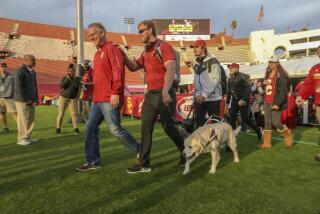Guided by Love
- Share via
SYLMAR — Guide Dogs of America, a training program that turns German shepherd, Labrador and golden retriever puppies into navigators for the blind, is looking for some help.
The organization, which Monday will celebrate its 50th anniversary with a golf tournament at North Ranch Country Club in Westlake Village, needs volunteers to raise puppies who will be guide dogs some day. Normally, the puppies are ready to begin training about 18 months after being placed in a temporary home.
But finding foster families for the pups can be tough.
“It’s very emotional to raise an animal and then let it go,” said Andi Krusoe, admissions and graduate service manager for the Sylmar-based school. “Raising a puppy takes a lot of work and some people can only do it once.”
The Sylmar program, founded in 1948 by retired aerospace worker Joseph Jones Jr., graduates 48 guide dogs each year. More than 2,000 guide dogs have completed the training during the past half century. The local school is one of 11 in the country affiliated with the Guide Dog Council for the Blind, a nonprofit organization.
Krusoe said 85 guide dogs from the Sylmar school have been assigned to people in the Los Angeles area who are legally blind. Statewide, about 180 have been placed, she said.
The school places the dogs with foster families once the dogs are 8 weeks old. Officials said the people who raise puppies make sure the prospective guide dogs successfully complete obedience school and can follow simple commands.
*
Guide dogs have to be compatible with any potential owner, so people who raise the pups train them to stay away from human food and off the bed, officials said.
“Dogs love sleeping on a human bed, but the habit is hard to break if a future owner doesn’t want to permit it,” said Cherry Teter of Reseda, who has been raising guide dogs for eight years.
The foster family must also expose the dog to a variety of public situations, such as going to restaurants, riding the bus and walking on busy city streets.
“It’s something I would hope someone would do for me if I were blind,” said Jacque Butler of Canyon Country, who began raising dogs for the program 11 years ago. “If you find something you enjoy doing and can use it to help someone at the same time, that’s great.”
Steve Burkman, director of training at the Sylmar school, said during the 18 months it is being raised, the puppy is evaluated for health or personality problems. Larger dogs are vulnerable to hip dysplasia, a disorder that causes the hip joint to dislocate. If problems persist, the animal makes a “career change” and is put up for adoption, he said.
Only dogs that come close to matching the talents of Air Bud make it through the program. About 40% are removed and are permanently adopted by the puppy raiser or someone else. Because so many of those who raise dogs decide to keep any who cannot serve as guides, the Sylmar school has a waiting list of about 100 local residents wanting to adopt a dog.
“It’s hard because they’re like your own child, and you want them to do well and go on to become a guide dog,” Teter said. “But the puppy raiser gets first choice if they leave the program.”
Teter, who could not resist keeping two dogs, said, “That’s my limit.”
*
Once a dog enters the program, the people who raised it cannot visit.
“Sometimes we have to remind people that they are helping the puppy to become an instrument for a person,” Burkman said.
To apply for a guide dog, applicants submit a report from a physician and a description of the general conditions under which the dog would be working. Those accepted wait two to six months before beginning training with a guide dog.
Burkman said all services are free to the person selected for a guide dog, though the cost to breed, raise and train one dog for the program is $25,000. Once the dog is trained, the new owner takes on such expenses as food and medical care.
*
For people like Bill Emerson, who lost his sight 19 years ago after complications from diabetes, the efforts of those who raise and train the puppies could not be more appreciated. He prefers the guide dog to a cane that sometimes got stuck in fences. Emerson, 55, said Sergio, his yellow Labrador of three years, also watches out for him in other ways.
One night, Sergio noticed that Emerson, a political advertising manager of programs and political sales at KNBC-TV Channel 4, became ill at work. Sergio led him to the nurse’s office at the television station.
“Even though it sounds amazing,” Emerson said, “that’s what these dogs are trained to do.”
More to Read
Sign up for Essential California
The most important California stories and recommendations in your inbox every morning.
You may occasionally receive promotional content from the Los Angeles Times.













